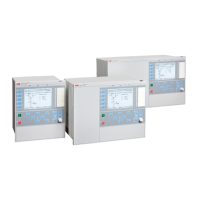15. Human machine interface
Local HMI
IEC13000239 V2 EN
Figure 12. Local human-machine interface
The LHMI of the IED contains the following elements:
• Graphical display capable of showing a user defined single
line diagram and provide an interface for controlling
switchgear.
• Navigation buttons and five user defined command buttons
to shortcuts in the HMI tree or simple commands.
• 15 user defined three-color LEDs.
• Communication port for PCM600.
The LHMI is used for setting, monitoring and controlling.
16. Basic IED functions
Time synchronization
The time synchronization function is used to select a common
source of absolute time for the synchronization of the IED when
it is a part of a protection system. This makes it possible to
compare events and disturbance data between all IEDs within a
station automation system and in between sub-stations. A
common source shall be used for IED and merging unit when
IEC 61850-9-2LE process bus communication is used.
17. Station communication
670 series protocols
Each IED is provided with a communication interface, enabling
it to connect to one or many substation level systems or
equipment, either on the Substation Automation (SA) bus or
Substation Monitoring (SM) bus.
Following communication protocols are available:
• IEC 61850-8-1 communication protocol
• IEC 61850-9-2LE communication protocol
• LON communication protocol
• SPA or IEC 60870-5-103 communication protocol
• DNP3.0 communication protocol
Several protocols can be combined in the same IED.
IEC 61850-8-1 communication protocol
IEC 61850 Ed.1 or Ed.2 can be chosen by a setting in PCM600.
The IED is equipped with single or double optical Ethernet rear
ports (order dependent) for IEC 61850-8-1 station bus
communication. The IEC 61850-8-1 communication is also
possible from the electrical Ethernet front port. IEC 61850-8-1
protocol allows intelligent electrical devices (IEDs) from different
vendors to exchange information and simplifies system
engineering. IED-to-IED communication using GOOSE and
client-server communication over MMS are supported.
Disturbance recording file (COMTRADE) uploading can be done
over MMS or FTP.
IEC 61850-9-2LE communication protocol
Single optical Ethernet port communication standard IEC
61850-9-2LE for process bus is provided. IEC 61850-9-2LE
allows Non Conventional Instrument Transformers (NCIT) with
Merging Units (MU) or stand alone Meging Units to exchange
information with the IED and simplifies SA engineering.
LON communication protocol
Existing stations with ABB station bus LON can be extended
with use of the optical LON interface. This allows full SA
functionality including peer-to-peer messaging and
cooperation between the IEDs.
SPA communication protocol
A single glass or plastic port is provided for the ABB SPA
protocol. This allows extensions of simple substation
automation systems but the main use is for Substation
Monitoring Systems SMS.
IEC 60870-5-103 communication protocol
A single glass or plastic port is provided for the IEC
60870-5-103 standard. This allows design of simple substation
automation systems including equipment from different
vendors. Disturbance files uploading is provided.
DNP3.0 communication protocol
An electrical RS485 and an optical Ethernet port is available for
the DNP3.0 communication. DNP3.0 Level 2 communication
Transformer protection RET670 2.0
1MRK 504 141-BEN C
Product version: 2.0
ABB 39

